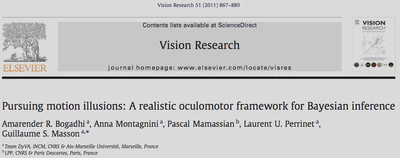Abstract
Accuracy in estimating an object’s global motion over time is not only affected by the noise in visual motion information but also by the spatial limitation of the local motion analyzers (aperture problem). Perceptual and oculomotor data demonstrate that during the initial stages of the motion information processing, 1D motion cues related to the object’s edges have a dominating influence over the estimate of the object’s global motion. However, during the later stages, 2D motion cues related to terminators (edge-endings) progressively take over, leading to a final correct estimate of the object’s global motion. Here, we propose a recursive extension to the Bayesian framework for motion processing (Weiss, Simoncelli, Adelson, 2002) cascaded with a model oculomotor plant to describe the dynamic integration of 1D and 2D motion information in the context of smooth pursuit eye movements. In the recurrent Bayesian framework, the prior defined in the velocity space is combined with the two independent measurement likelihood functions, representing edge-related and terminator-related information, respectively to obtain the posterior. The prior is updated with the posterior at the end of each iteration step. The maximum-a posteriori (MAP) of the posterior distribution at every time step is fed into the oculomotor plant to produce eye velocity responses that are compared to the human smooth pursuit data. The recurrent model was tuned with the variance of pursuit responses to either p̈ure1̈D or r̈̈e ̈̈motion. The oculomotor plant was tuned with an independent set of oculomotor data, including the effects of line length (i.e. stimulus energy) and directional anisotropies in the smooth pursuit responses. The model not only provides an accurate qualitative account of dynamic motion integration but also a quantitative account that is close to the smooth pursuit response across several conditions (three contrasts and three speeds) for two human subjects.

- See a followup in(2012). Motion-based prediction is sufficient to solve the aperture problem. Neural Computation.